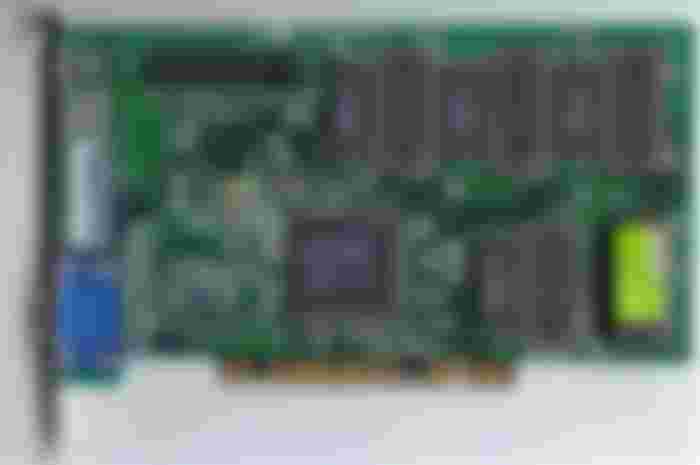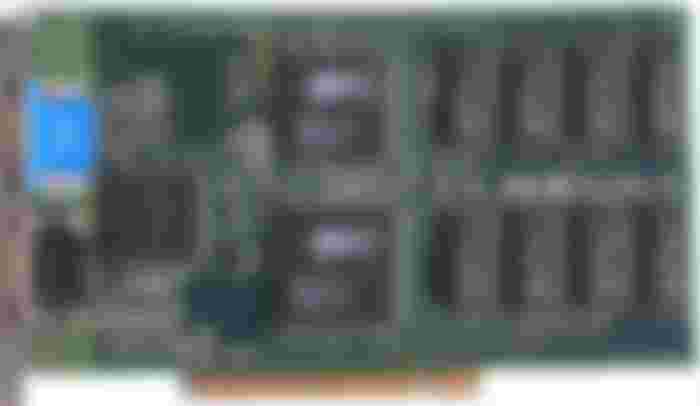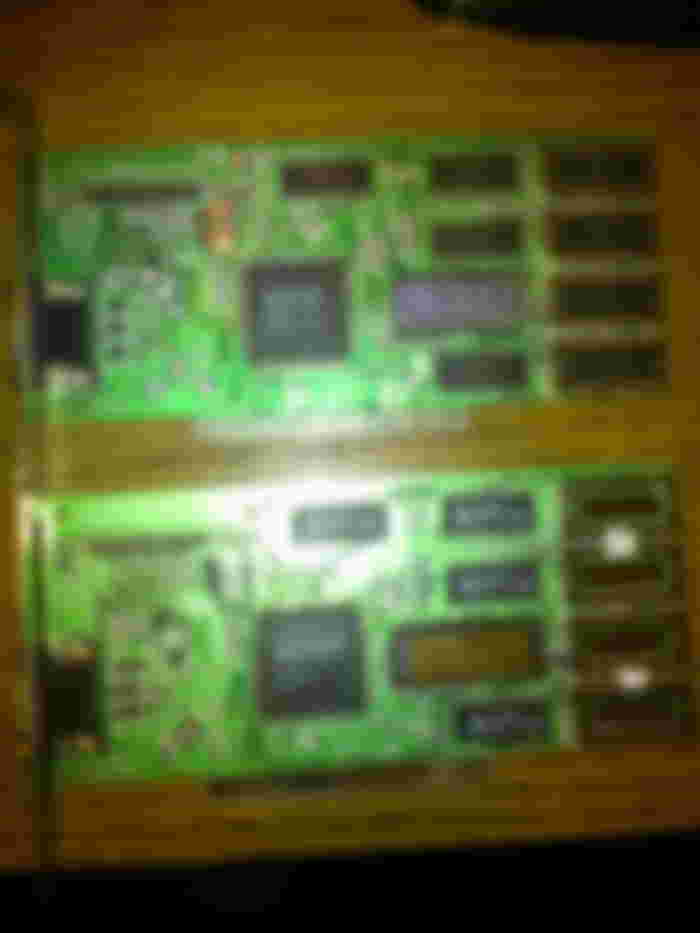Nowadays, the computer of an AAA gamer has a strong dedicated video card. Even a low-end graphics card will have 3D capabilities, to run games and CAD programs, design software. If for some reason, there are no 3D chip available, or the hardware drivers could not be installed, a strong, multi-threaded software renderer will be offered under both Linux and Windows operating system. People take these capabilities granted, but that was not always the case.

3D acceleration is older than you think
People rarely know about the first video cards with actual 3D capabilities. Corporations, like nVidia, aren't even among the first corporations to offer 3D cards. Some people remember the 3dfx corporation with their 3dfx Voodoo family as an early 3D accelerator, which is more close to the truth, but actually the Voodoo1 was not the first 3D graphics card. The first 3D cards were non-standardized products and ASIC chips, supporting only their own proprietary API.
The early 3D cards was not really usable
Not counting the Silicon Graphics IrisVision (a professional workstation video card costing a house), the very first 3D accelerator card was released by Creative. The card was called Creative Labs 3D Blaster. Creative already had sound cards at the time, called Sound Blaster, so the 3D Blaster name choosen to follow this analogy. The chip was actually made by 3Dlabs. The card only supported like 6 or 7 games in total, used its own proprietary API, and never got popular. The card was released for 486 systems, but the performance of the video accelerator was barely higher than the software rendering on the 486. The card supported about 200 000 polygons per second, and resultions up to 640x480. It had 1 MByte frame buffer memory, and 1 MByte texture memory. Despite of these specifications, the card produced very similar picture quality like the early 3D software renderers on the 486, without any notable speed differences. The card didn't get popular.

The IrisVision. Picture by the VGAmuseum.
The first true 3D card
S3 was producing video cards quite a while. They was known for good 2D picture quality, and faster 2D chips. S3 was pioneering windows GUI acceleration alongside with Tsend Labs, which was their greatest rival in the early 90's. S3 was able to successfully port their video cards to their newest PCI slot, with their S3 Vision and S3 trio line. S3 was the first big corporation that actively researched 3D rendering. In the early 90's, S3 was preparing to create the world's first actual 3D card.
Planning the card
Unlike other corporations thinking with proprietary solutions and specialized ways to program for their chip, S3 was thinking on something more universal solution. Microsoft was announcing their plans for the new DirectX component, called Direct3D, which would be a standard for 3D. S3 was already having experience with GDI and font acceleration in Windows, they understood that standardization is the most important step. They grouped up with Microsoft, and after researching the features what programmers needed, they came up with the proper plans. S3 understood that the triangle based rendering with colors, Z-buffer, RGB and RGBA textures will be the future of the industry.
Their goal was to create a cheap video card
Unlike the old competitors who was thinking in multi-chip solutions and large, specialized cards, S3 was focused to integrate the new computing units into their existing line of graphics products. Their previously successful S3 Trio64 line had a strong 2D core, it was able to support 2 or 4 MByte on-board memory. To keep the things simple, S3 decided to keep the pin-compatibility with the Trio64, and integrated the new 3D core into a new chip.
S3 Virge - the first 3D card shocks the world
The first 3D chip was called the S3 Virge. S3 pushed the previous 2D only cards to the low-end, and they have released the 3D-capable Virge to the mid-range and to the high-end. The mid-range variation only had 2 MByte installed, which quickly turned to be too few for 3D gaming - althrough early 3D games was able to work with only 2 MByte. The high-end version had 4 MByte of RAM. Its noteworthy that the 2 MB models was upgrade-able to 4 MByte, by just simply sliding in the external memory clips to the open memory sockets. This was important, as it turned out later on, the 2 MByte was not adequate for most of the 3D games.

S3 Virge tooks the gamer crown
The card was released in 1995. The S3 Virge 4 MB PCI was about $200. The card has its own API for 3D acceleration under DOS, called S3D, later on they also have released the S3D API for Windows, hacked on top of GDI. Microsoft released several version of DirectX at the end of 1995 and they have released new version of the Direct3D API with DirectX 2 in the early 1996. Several games released for the new DirectX standard, such as the Lego Islands, Lego Rock Racer, Mechwarrior2. And also some games like Screamer2, Tomb Raider got patched to support the S3 Virge natively, or to support the new DirectX standard.
Software rendering:
S3 Virge:
The S3 Virge had good 2D quality, as the 2D core was clone of their previous Trio line. The card supported 16 bit and 24 bit display modes, and up to 800x600 in 24 bit under 60 Hz (1024x768 was also supported, but only with limited refresh rate, or limited color depths). When using 3D, it was capable of rendering games in 320x240 at about 15 fps. The speed of the card was about the double of the speed of software rendering on a 90 MHz Pentium1. The card also offered bi-linear texture filtering, making the image look nicer.
Competitors shocked
Althrough the S3 Virge is unable to offer playable frame rates in 640x480 or above, the card is cheap. Even the OEMs find the card viable, and the card is being sold in big quantities. The card is a totally integrated solution, the drivers are upgraded regularly, the new DirectX standards are getting adopted widely, increasing the adoption of the card. As more and more game is released to support it, the competitors of S3 got shocked, and they got forced to speed up their releases of their own cards.
nVidia appears on the scene
nVidia released its first 3D chip, the NV1, at the same year as the Virge. The card manifested as Diamond Edge 3D, which also carried and integrated sound card. The card failed the market because nVidia didnt realised the importance of compatibility with DirectX, which was only an upcoming standard at the time. The card was expensive, and it failed the market, eventually the demand disappeared for the card. The chip internally used a quadratic polygon rendering method, which is less flexible compared to triangle-based rendering. The fiasco almost bankrupts nVidia.
Mass exctinction within months
Former competitors of S3 have no working 3D solutions. More than half year has been passed, and S3 cards taking over the mid range and the high-end. Trident did a paper-launch of the T3D9692 in 1996, but the chip failed the market. They will have the money to retry later on. Tseng Labs are not being able to produce any 3D capable chip, and they lose the game. Early video chip manufacturers, such as Everex, Fida, BOCA, Fortron, Goldstar, GVC, Jaton, Kouwell, Magnavox, Maxilogic, Paradise, Sigma, Quadram, DTK, Tecmar, ASKA, AUVA, Cardinal, Danmere, Diamond, Delco, SPEA, Suntec, Yuan tech, Western Digital, and dozens of other corporations, being bankrupted single handedly by Virge. Some of the corporations giving up on their own chips, and will focus only on manufacturing cards. Some retire to other industries, such as the Western Digital and Goldstar. Cirrus Logic and ATi barely avoids bankruptcy.
ATi Rage
In 1996, ATi creates a 3D chip to compete the Virge. ATi tried to copy the tactic of S3. They have upgraded the Mach64 core with 3D capabilities, eventually renaming the chip to ATi Rage. The chip was announced in 1995, but only materialized in 1996. The speed was notably slower than the Virge, and most cards are being equipped with only 2 MByte of VRAM, which basically makes the card useless. The card lacks proper support of Z-buffering at hardware-level.
ATi Rage 2
Before the end of 1996, ATi released another generation of chips. This is the first real competitor to the Virge. The ATi Rage 2 comes in PCI form factor. Its a minimalistic integrated card similar to the Virge. The price is similar. ATi Rage 2 is finally able to beat the Virge. The Rage2 offers up to 4 MByte memory, and PCI interface. ATi repeats some of its mistakes: some variants with 2 MByte memory also released, but those were quite unusable for 3D. The card is about 10-20% faster than the Virge, and offers better compatibility with effects and alpha-blended textures. The chip is sort of buggy, the bilinear filtering looks quite unfiltered. The chip later gets an update, called Rage 2+, which will also be available in AGP. The Rage 2+ has better bilinear filtering and supports MPG playback acceleration, but its essencially the same 3D core. The card loses barely any speed when using it in 640x480 compared to 320x240 as it has good fill-rate. However, the triangle engine is weak, and its unable to pump out good framerates, if these are a lot of polygons present on the scene, regardless of the resolutions.

Picture: Rage2+, which was released a few months after the Rage2.
3dfx Voodoo
The 3dfx Voodoo1 is being announced in 1995, however, that's only a paper-launch. 3dfx promises playable frame rates at 640x480. 3dfx focuses on it own API called Glide. The card is not a video card, only an accelerator card, therefore the computer needs a normal video card as well. This makes the Voodoo1 less appealing for OEM usage. Luckily for S3 and ATi, the actual appearance of the Voodoo 1 cards was not happened before 1996, so ATi and S3 sold millions of units already.

Voodoo1: picture by VGAmuseum
The performance of 3dfx Voodoo
The performance of the 3dfx Voodoo shadowed the performance of the Virge. Virge was only able to pump out playable frame rates at 320x240, the 3dfx Voodoo1 was able to achieve about 20 fps even in 640x480. The card has two giant chips. One is for the frame buffer operations, and the second one for texture management. The Voodoo1 uses 4 mbyte of memory (6 MByte variations were released as well, but they didnt became popular). The Voodoo1 offered better graphics quality than the ATi and S3 solutions. However, windowed 3D was not possible on the card, as the card was a 3D accelerator only, and lacked any type of 2D engine. The card was connected with a passthrough cable to the main video card, and overtook the video display when 3D is activated. The card focused on its own proprietary API called Glide, but they have also made Direct3D drivers. At least later on, the first instances of D3D implementations were horrible.
Problems with the 3dfx Voodoo
In a previous article, i have explained the bankruptcy of 3dfx in detail. You can read that article in this link. To sum up in short, 3dfx was not able to appear on the market till the end of 1996, it lacked windowed 3D support. The Voodoo was offering good performance under AAA games, but every non-AAA game was suffering on it. So for example, you was not able to play a random windowed 3D chess or Machjong game as you chatted with your friend, or edited your documents, but this problem only surfaced later on, as the early DirectX based games were using full-screen anyway.
3Dlabs Permedia
3Dlabs Permedia was a PCI card, using 4 MByte of video memory. The card was annouced in 1996, and it promised similar performance to the Voodoo1, meanwhile it was only a one-chip card. The first Permedia was however not produced by too many partners, and the chip suffered some issues with filtering and alphablending. The chip was not strong enough to run most games in 640x480 at 20 fps. The chip was later on replaced by the Permedia2 line, which is strong enough for 640x480, and which was produced for the PCI and for the AGP slot as well. However that card only appeared one year later. Due to the card is not being produced in large quantities, it was not a real competititor for S3 and ATi till the appearance of Permedia2, so S3 won some time.
Matrox enters the game
The Matrox Mystique was released in 1996 as well. The card was released for the PCI slot, and it had maximum 4 MByte memory (some models are upgrade-able to 8 MByte). Matrox followed a similar path as ATi and S3 when releasing the Mystique. They have redesigned their previous MGA chip to have 3D capabilities. The performance of the Mystique was similar to the Rage2, so it was a threat for S3 and ATi as well. The card had issues with texture filtering when alpha-blending was enabled. The card was able to run some titles at 640x480 at 20 fps or above, which resulted a moderate success for the card. The card also had nice 2D quality, comparable to S3.
S3 Virge DX
S3 got bombarded with competitors for a year. 3dfx, Matrox, 3Dlabs, ATi have annouced and released various products in 1995 and 1996, which eventually reached the performance of the Virge. To respond to this threat, S3 released a new variation of the Virge, called the S3 Virge DX. S3 have upgraded the chip. They have optimized the texture filtering implementations, which resulted less speed drop when filtering was applied. They have modified the chip to support 60 Hz and 24 bit in 1024x768 and above, to improve 2D. They have increased the clock speeds of the chip.

S3 strikes again
The Virge DX gave about 30% performance increase over the previous Virge. There is another significant difference as well: the performance of the original Virge rapidly fell unplayable above 320x240. The new Virge however was scaling better. Its possible to play some games in 400x300 or even in 512x384 with the Virge DX, which is smaller than the potential power of Permedia or the overwhelming power of the new Voodoo1. However, its enough to beat the Rage2, and after some price cuts, create a segment for low-end 3D mass-cards. The Virge DX, however, has a little bit lower 2D quality than the Virge, due to some price cuts on the PCB.

Picture: S3 Virge vs S3 Virge DX
Originally both came with 4 MByte, however the previous owner took out the memory expansions, so i only have memory for one card.
You can see smaller and lower quality capacitors on the Virge DX card, as a price-decreasing method. Otherwise, the two PCB is identical. I have decided to extract the RAM from the Virge, and put them to the Virge DX, as it gives better performance for me.
Then we arrive in 1997
In 1997, a lot of more solutions enter to the market. The second generation of graphics cards appear. Intel releases its first 3D card, the i740. SiS enters with the SiS 6326, Trident returns with the Blade3D. nVidia releases the Riva128, which saves them from going bankrupt. ATi comes out with the Rage Pro, and Cirrus Logic releases the Laguna3D. Matrox releases the G100. These cards focus on competing with the Voodoo1 and they can offer playable frame rates at 512x384, 640x480, and some of them, even in 800x600 in some games.
The first generation of graphics cards are being withdrawn from the market, except the Virge DX, which continues to be a popular low-end choice for a few more years. It even gets a small silicon update and AGP support, being re-branded as Trio3D later on (with bigger clock speeds).

Aftermath
The S3 Virge family started the 3D revolution, and shaped the path for 3D as we know it today. Behold these cards, they are not even expensive: despite of being collectible items, you can easily pick them up on second-hand online shops for $10 plus shipment.








Amazing